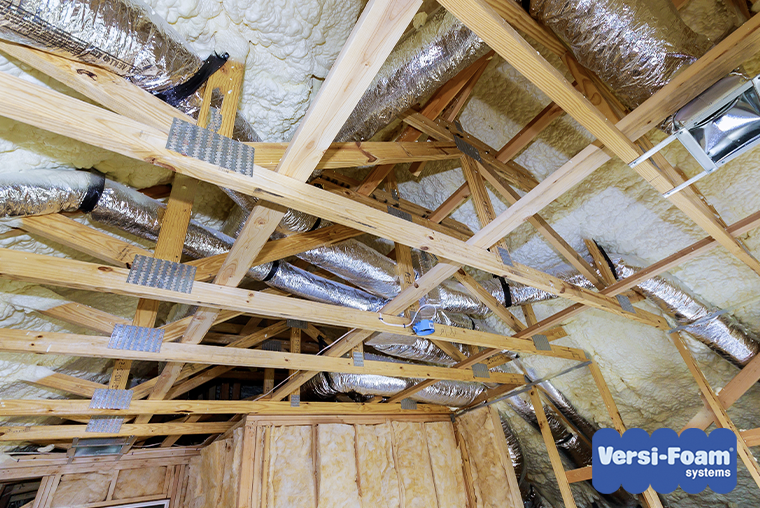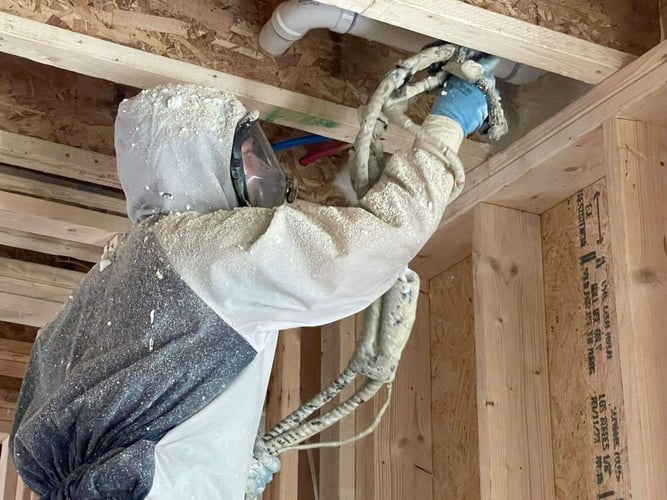Typical Myths Regarding Spray Foam: Debunking the Misconceptions
Spray Foam: The Ultimate Solution for Air Sealing and Insulation
Spray foam insulation has arised as a leading solution for effective air sealing and thermal insulation, providing an one-of-a-kind mix of residential properties that establish it apart from conventional techniques. Its capability to broaden and fill up spaces makes it specifically reliable in protecting against air leak, which can significantly impact power efficiency. However, understanding the full extent of its advantages, installment procedures, and contrasts with other insulation types is essential for making informed decisions. As we explore these facets, the ramifications for both new buildings and retrofits become significantly considerable. What elements should influence your selection?
What Is Spray Foam?
Spray foam is a functional insulation material that incorporates the principles of air securing and thermal resistance to enhance power efficiency in buildings. Made up mainly of polyurethane or various other similar substances, spray foam is used as a liquid that broadens upon call with surfaces, producing a solid, constant layer of insulation. This special residential or commercial property allows it to fill up voids, cracks, and voids that traditional insulation materials may neglect, providing a superior air seal.
There are two primary kinds of spray foam: open-cell and closed-cell. Open-cell spray foam is lighter and extra adaptable, providing superb sound absorption and a reduced R-value per inch - Spray Foam. On the other hand, closed-cell spray foam is denser, offering a higher R-value, wetness resistance, and included architectural integrity to developing parts
The application procedure generally includes specific tools, ensuring a seamless application that abides by different substrates, including steel, timber, and concrete. This flexibility makes spray foam appropriate for both new buildings and retrofitting existing structures. Its capability to develop a closed barrier dramatically contributes to reducing energy usage and boosting indoor air high quality, thereby making it a preferred selection among home builders and home owners alike.
Advantages of Spray Foam Insulation
One of one of the most significant benefits of spray foam insulation is its phenomenal capacity to produce a constant air obstacle, which effectively reduces energy loss. Unlike standard insulation materials, spray foam increases to fill up gaps and cracks, guaranteeing that air leak is dramatically lowered. This particular not only boosts energy effectiveness but also results in reduce utility costs with time.
Furthermore, spray foam insulation offers superior thermal resistance, contributing to an extra secure indoor setting. Its high R-value per inch permits reliable insulation in constrained spaces, making it perfect for attic rooms, wall surfaces, and crawl areas. Furthermore, the moisture-resistant properties of spray foam aid stop mold and mold growth, advertising much healthier living conditions.
An additional crucial benefit of spray foam insulation is its sound-dampening qualities (Spray Foam). It effectively decreases noise transmission in between spaces, creating a quieter and much more comfy home environment. The toughness of spray foam additionally attracts attention, as it does not droop or settle in time, preserving its performance throughout its lifespan
Just How Spray Foam Works
Understanding exactly how spray foam insulation functions is important for appreciating its effectiveness in air securing and thermal resistance. Spray foam insulation is composed of 2 key parts: isocyanate and polyol resin. When these components are blended, they undergo a chain reaction that causes the product to increase swiftly, producing a thick foam that fills gaps, tooth cavities, and fractures.
As the foam expands, it adheres to surface areas, developing a closed seal that considerably decreases air seepage. This particular makes spray foam insulation extremely effective at preventing drafts and dampness penetration, which can lead to power loss and damage over time. In addition, the closed-cell variation of spray foam offers premium thermal resistance because of its inflexible framework, efficiently minimizing warm transfer.
The unique residential or commercial properties of spray foam permit it to satisfy irregular surface areas, ensuring thorough coverage and a smooth obstacle. Because of this, spray foam insulation not just enhances energy performance but additionally contributes to enhanced indoor air high quality by reducing the build-up of contaminants and irritants. Ultimately, comprehending the technicians behind spray foam underscores its function as a premium choice for insulation and page air sealing in both household and commercial applications.
Setup Refine Review

Before installation, the area needs to be adequately cleaned up and prepped, making sure that surface areas are devoid of particles, dampness, and dust. Since contaminants can jeopardize attachment and overall efficiency, this step is important. When the location is prepared, the application involves blending the 2 parts of the spray foam, which broadens upon get in touch with and fills up spaces successfully.
Trained professionals ought to carry out the setup, making use of specific tools to make certain uniform protection and ideal density. Safety and security precautions, including putting on protective gear and ensuring correct ventilation, are necessary during this process. After application, the foam typically treatments swiftly, forming a strong barrier that boosts energy efficiency.
Comparing Spray Foam to Conventional Insulation
When reviewing insulation options, spray foam insulation stands out in comparison to typical materials such as fiberglass and cellulose. Unlike fiberglass and cellulose, which can enable air infiltration, spray foam increases upon application, filling spaces and holes to produce a closed seal.
In addition, spray foam provides a higher R-value per inch than standard insulation kinds, offering more efficient thermal resistance in a thinner account. This particular is particularly useful in areas with minimal tooth cavity deepness. Spray foam is immune to dampness and mold and mildew development, which can be a substantial concern with cellulose and fiberglass, especially in damp atmospheres.
Nevertheless, spray foam insulation normally lugs a greater ahead you could look here of time expense than its typical equivalents. House owners should evaluate this preliminary investment versus long-term energy cost savings and performance advantages. Inevitably, while both insulation kinds serve find this their purpose, spray foam emerges as an extra innovative remedy for contemporary insulation requirements, especially in terms of air securing and thermal performance.

Conclusion
In summary, spray foam insulation stands for a highly effective option for attaining optimal air sealing and thermal resistance. Its unique properties, including wetness resistance and noise dampening, make it ideal for numerous applications in both new buildings and retrofitting jobs (Spray Foam). Although the initial costs may be higher compared to standard insulation products, the lasting advantages, such as substantial power financial savings and improved indoor air quality, justify the investment and underscore its value in modern building practices.
Spray foam insulation has actually arised as a leading option for efficient air sealing and thermal insulation, offering an one-of-a-kind mix of buildings that establish it apart from standard methods.Spray foam is a versatile insulation product that integrates the principles of air securing and thermal resistance to improve energy performance in structures.When assessing insulation options, spray foam insulation stands out in contrast to conventional products such as fiberglass and cellulose. Eventually, while both insulation types offer their function, spray foam arises as a much more advanced remedy for contemporary insulation needs, specifically in terms of air sealing and thermal efficiency.
In recap, spray foam insulation represents an extremely effective remedy for accomplishing optimum air sealing and thermal resistance.